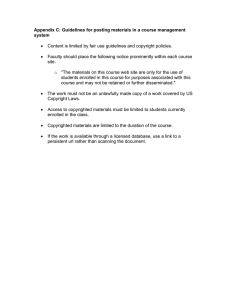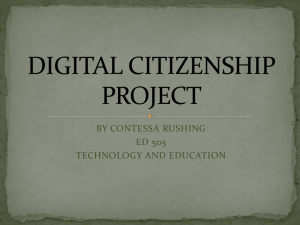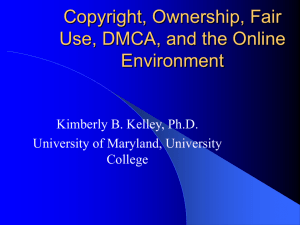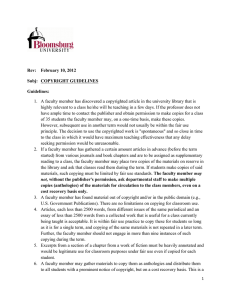Document 13180153
advertisement
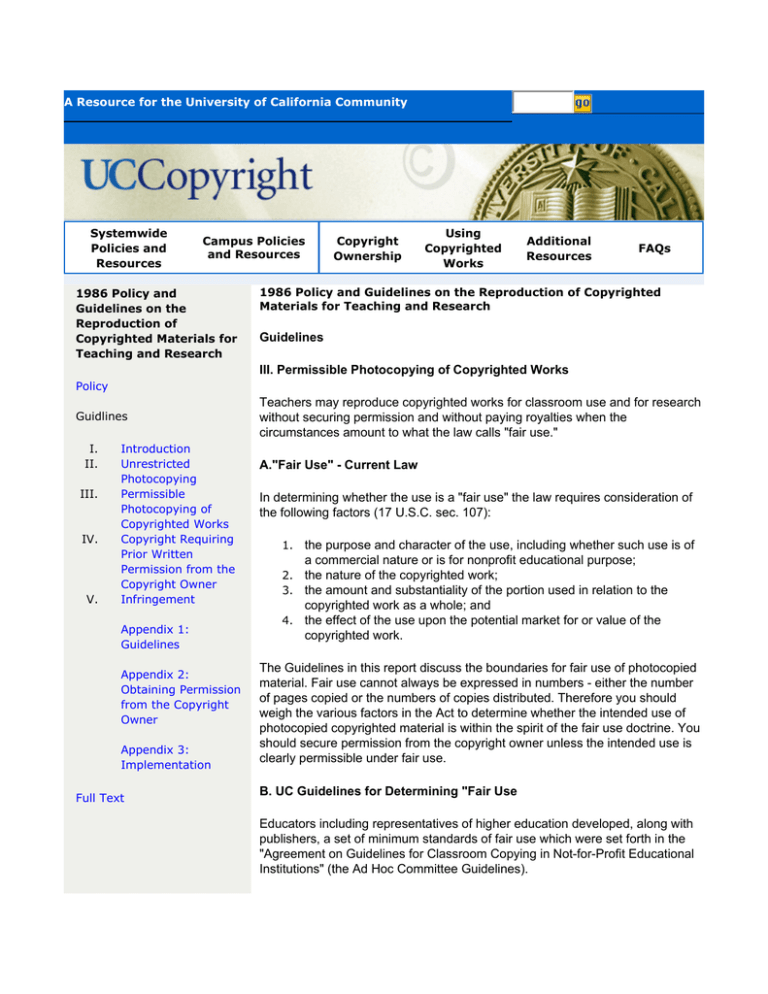
A Resource for the University of California Community Systemwide Policies and Resources Campus Policies and Resources 1986 Policy and Guidelines on the Reproduction of Copyrighted Materials for Teaching and Research Copyright Ownership Using Copyrighted Works Additional Resources FAQs 1986 Policy and Guidelines on the Reproduction of Copyrighted Materials for Teaching and Research Guidelines III. Permissible Photocopying of Copyrighted Works Policy Guidlines I. II. III. IV. V. Introduction Unrestricted Photocopying Permissible Photocopying of Copyrighted Works Copyright Requiring Prior Written Permission from the Copyright Owner Infringement Appendix 1: Guidelines Appendix 2: Obtaining Permission from the Copyright Owner Appendix 3: Implementation Full Text Teachers may reproduce copyrighted works for classroom use and for research without securing permission and without paying royalties when the circumstances amount to what the law calls "fair use." A."Fair Use" - Current Law In determining whether the use is a "fair use" the law requires consideration of the following factors (17 U.S.C. sec. 107): 1. the purpose and character of the use, including whether such use is of a commercial nature or is for nonprofit educational purpose; 2. the nature of the copyrighted work; 3. the amount and substantiality of the portion used in relation to the copyrighted work as a whole; and 4. the effect of the use upon the potential market for or value of the copyrighted work. The Guidelines in this report discuss the boundaries for fair use of photocopied material. Fair use cannot always be expressed in numbers - either the number of pages copied or the numbers of copies distributed. Therefore you should weigh the various factors in the Act to determine whether the intended use of photocopied copyrighted material is within the spirit of the fair use doctrine. You should secure permission from the copyright owner unless the intended use is clearly permissible under fair use. B. UC Guidelines for Determining "Fair Use Educators including representatives of higher education developed, along with publishers, a set of minimum standards of fair use which were set forth in the "Agreement on Guidelines for Classroom Copying in Not-for-Profit Educational Institutions" (the Ad Hoc Committee Guidelines). These standards are reproduced in their entirety in Appendix 1 and can be used as a practical approach to determine fair use. Any copying that falls within the Ad Hoc Committee Guidelines is considered to be fair use and permissible. Since these standards are often not realistic in a University setting, the following Guidelines should be used to judge if intended photocopying of copyrighted materials constitutes fair use in teaching and research at the University of California. 1. Single Copying for Teachers A single copy may be made of any of the following by or for a teacher at his or individual request for his or her scholarly research or use in teaching or preparation to teach a class: a. b. c. A chapter from a book; An article from a periodical or newspaper; A short story, short essay or short poem, whether or not from a collective work; d. A chart, graph, diagram, cartoon, or picture from a book, periodical, or newspaper; 2. Multiple Copies for Classroom Use Multiple copies (not to exceed in any event more than one copy per pupil in a course) may be made by or for the teacher giving the course for classroom use or discussion provided that: a. The copying does not substantially exceed the test of brevity as defined below; and b. Meets the cumulative effect test as defined below; and c. Each copy includes a notice of copyright. 3. Definitions a) Brevity 1. Poetry: A complete poem if less than 250 words or, from a longer poem, an excerpt of not more than 250 words. 2. Prose: Either a complete article, story or essay of less than 2,500 words or an excerpt of not more than 2,500 words from any prose work. 3. Illustration: One chart, graph, diagram, drawing, cartoon, or picture per book or per periodical issue. In some cases, such illustrations are copyrighted individually and cannot be reproduced under fair use. (See IV C below) b) Cumulative Effect 1. The copying of the material is for only one course per class term of the instructor for whom the copies are made. 2. Not more than one short poem, article, story, essay or two excerpts may be copied from the same author, nor more than three from the same collective work or periodical volume during one class term. 3. There shall not be more than nine instances of such multiple copying for one course during one class term. The limitations stated in (1) and (2) above shall not apply to current news periodicals and newspapers and current news sections of other periodicals. 4. Prohibitions as to a) and b) above Notwithstanding any of the above, the following shall be prohibited: a) There shall be no copying of or from works intended to be "consumable" in the course of study or of teaching. These include workbooks, exercises, standardized tests and test booklets, answer sheets, and like consumable materials. b) Copying shall not: 1. substitute for the purchase of books, publishers' reprints, or periodicals; 2. be directed by higher authority; c) No charge shall be made to the student beyond the actual cost of the photocopying. C. Situations Not Specifically Covered by UC Guidelines The doctrine of "fair use" may permit reproduction of copyrighted works in excess of the word limit restriction specified in the UC Guidelines. 1. Since this is an area of unclear legal definition, you should use caution and discretion in such copying and should seek advice from the General Counsel's Office for a legal opinion, or request prior written permission directly from the copyright owner to perform copying substantially the limits enumerated in the Guidelines. 2. Any questions regarding the application of the Guidelines in specific cases, whether a work is covered under copyright protection, or the ways to secure permission from publishers should also be referred to the General Counsel.
